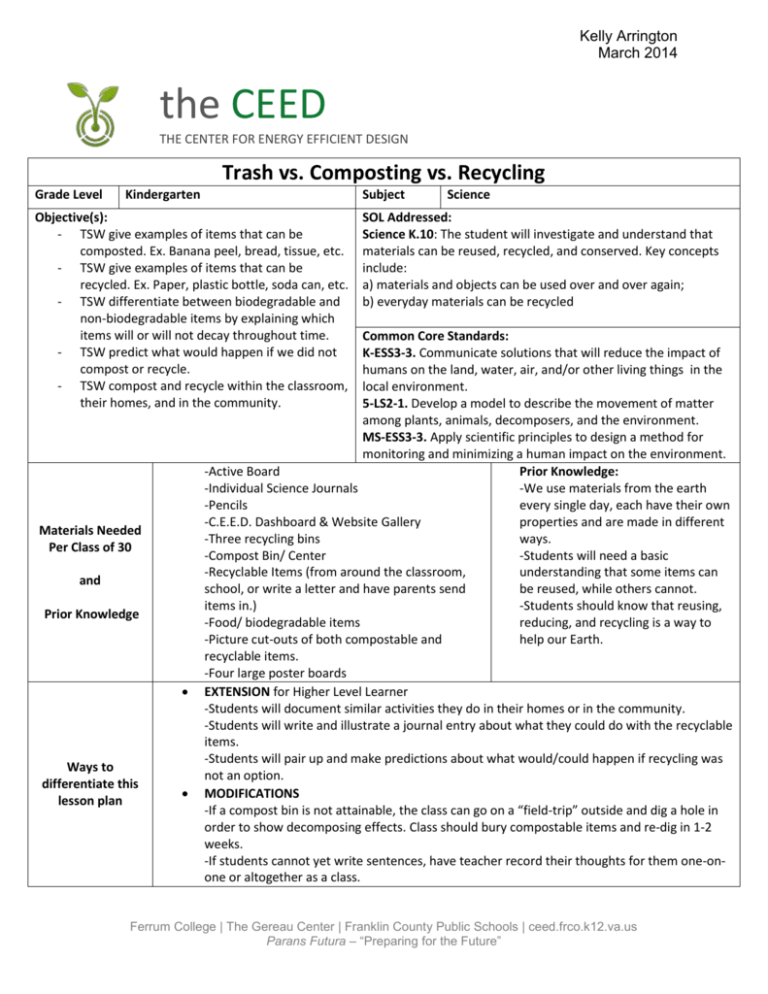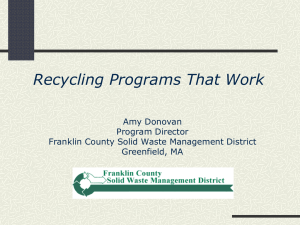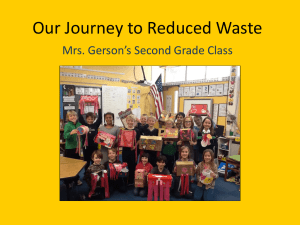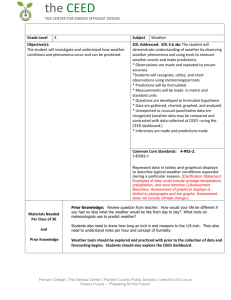Word - The Center For Energy Efficient Design
advertisement

Kelly Arrington March 2014 the CEED THE CENTER FOR ENERGY EFFICIENT DESIGN Trash vs. Composting vs. Recycling Grade Level Kindergarten Subject Objective(s): - TSW give examples of items that can be composted. Ex. Banana peel, bread, tissue, etc. - TSW give examples of items that can be recycled. Ex. Paper, plastic bottle, soda can, etc. - TSW differentiate between biodegradable and non-biodegradable items by explaining which items will or will not decay throughout time. - TSW predict what would happen if we did not compost or recycle. - TSW compost and recycle within the classroom, their homes, and in the community. Materials Needed Per Class of 30 and Prior Knowledge Ways to differentiate this lesson plan Science SOL Addressed: Science K.10: The student will investigate and understand that materials can be reused, recycled, and conserved. Key concepts include: a) materials and objects can be used over and over again; b) everyday materials can be recycled Common Core Standards: K-ESS3-3. Communicate solutions that will reduce the impact of humans on the land, water, air, and/or other living things in the local environment. 5-LS2-1. Develop a model to describe the movement of matter among plants, animals, decomposers, and the environment. MS-ESS3-3. Apply scientific principles to design a method for monitoring and minimizing a human impact on the environment. -Active Board Prior Knowledge: -Individual Science Journals -We use materials from the earth -Pencils every single day, each have their own -C.E.E.D. Dashboard & Website Gallery properties and are made in different -Three recycling bins ways. -Compost Bin/ Center -Students will need a basic -Recyclable Items (from around the classroom, understanding that some items can school, or write a letter and have parents send be reused, while others cannot. items in.) -Students should know that reusing, -Food/ biodegradable items reducing, and recycling is a way to -Picture cut-outs of both compostable and help our Earth. recyclable items. -Four large poster boards EXTENSION for Higher Level Learner -Students will document similar activities they do in their homes or in the community. -Students will write and illustrate a journal entry about what they could do with the recyclable items. -Students will pair up and make predictions about what would/could happen if recycling was not an option. MODIFICATIONS -If a compost bin is not attainable, the class can go on a “field-trip” outside and dig a hole in order to show decomposing effects. Class should bury compostable items and re-dig in 1-2 weeks. -If students cannot yet write sentences, have teacher record their thoughts for them one-onone or altogether as a class. Ferrum College | The Gereau Center | Franklin County Public Schools | ceed.frco.k12.va.us Parans Futura – “Preparing for the Future” Anticipatory Set: How will the teacher introduce the lesson to the students? Teacher will come into classroom tired from carrying a huge bag of “trash” she found lying around the school. Introduction/ Anticipatory Set Questions to ask students: Why do people liter? Why shouldn’t we liter? Why do you think I decided to pick this trash up? Would you? Why or why not? What should we do with this bag of trash? What happens to trash? Are there options rather than simply taking it to the dump? Introduction: Vocabulary Terms: Reuse, Reduce/ Conserve, Recycle, Compost, Biodegradable, Non-biodegradable First the teacher will bring out the objects from the trash bag one by one and show students. The teacher will begin to construct a list of the names of items on the active board. (Ex. Banana peel, milk bottle, piece of bread, soda can, wire, apple, tissue, piece of paper, etc) The teacher will explain that there are two types of trash listed: biodegradable and non-biodegradable. Explain that biodegradable trash can easily decay, while the other types of trash will not. Predictions: Ask students to predict which objects listed will decay and circle those items on the board. Discussion Questions: What does decay mean? Why does it matter if some trash is able to decay and some trash is not? Should this fact change the way we “take out our trash?” What makes you think _____ is biodegradable? Why isn’t _____ biodegradable? What is the difference in these two items? If non-biodegradable items cannot decay, what happens to them? What happens to the items that can decay? Day One: Guided Practice 1. Teacher will explain to students that biodegradable items can be “recycled” naturally through a process called composting. What is recycling? Does anyone know? Teacher will listen to student answers and facilitate student discussion. What can we recycle? Move on to explain that composting is a way for nature to recycle biodegradable items, like the ones the students made predictions about. 2. As a class, use student participants to prepare the compost bin. Explain that when composting takes place, usually only biodegradable items are put in the soil, but because we aren’t 100% sure which trash items will decay, we will experiment with all the trash items. Have students mix soil, grass clippings, and spray water into compost bin. Next, have students take turns adding both biodegradable and non-biodegradable items to compost bin (banana peel, apple, bread, tissue, plastic bottle, wire, soda can, etc). 3. Brainstorm as a class what will happen to the compost bin within the next week. Will the items stay as they are? Will they disappear? Which ones will decay? What does decay look like? What will happen to the items we predicted as non-biodegradable? (Have student volunteers mix and spray compost bin with water daily for the next one-two weeks: one week will be a good start for decaying while two weeks will be in the middle of the decaying process). Day Two: Ferrum College | The Gereau Center | Franklin County Public Schools | ceed.frco.k12.va.us Parans Futura – “Preparing for the Future” 1. After one to two weeks, gather as a class and observe and explore the class compost bin. Allow students to participate in an open discussion of their observations. What has taken place over the time the items were composting? Which items have/ or are starting to decay? How can you tell? Are some of the items exactly as they were left? Why didn’t they change? What does this mean? 2. Re-visit the predictions the class made before the composting experiment. Discuss if the predictions were correct. Have students “log” the outcome of the composting experiment by labeling one page as “Can Decay” and another page as “Can’t Decay” and drawing pictures of corresponding items under their correct label. Day Three: 1. Revisit science logs from previous day. Have students discuss what they have learned about composting by leading a series of questions: What did we learn from doing the composting experiment? Why would we want trash to decay rather than throwing it away? What is decaying? Give feedback and allow students to bounce answers off of each other. Continue questioning until a student brings up that composting is nature’s way of recycling. What does recycling mean? How does nature recycle? If composting is nature’s way of recycling? How can we recycle? 2. Have students look at their science logs and tell about which items they think can be recycled in a way other than composting. Why do we need to go further than just composting? How does this help the Earth? What happens when WE recycle? Lead students in discussion by looking at their “Can’t Decay” page in their science logs. What do these items have in common? 3. On the active board, visit the website www.starfall.com/earthday. Have students come up one at a time to separate the recyclable items into their correct recycling bins. 4. Discuss the difference in composting and recycling ourselves. Why are both equally important? Day Four: 1. The teacher will have a trash bag filled with both biodegradable and non-biodegradable items. At the front of the room there will be a trashcan, the compost bin, and three recycling bins labeled: aluminum, plastic, paper. Students will come to the front, pull out an item from the bag, and choose its proper place with the help from classmates. (Students will be tempted to throw items into trashcan first, but remind them that is the LAST resort!) 2. When all the items have been separated into their proper places, show the class the trashcan vs. a trashcan from a regular school day (less trash). Lead students in a class discussion. Why is there less trash? Why is this a good thing? Where does trash go vs. compost and recyclables? 3. Discuss what happens to the items in the recycling bins. Explain how these items are broken down and made new. Use the CEED Website Gallery and Data Dashboard (http://ceed.frco.k12.va.us/gallery) to show students real life examples of ways that items can be recycled: tires for the sidewalk, blue jeans for the sound insulation, etc. Explain that even our compost could be used to help plant on the green roof. Allow for students to give other examples they may be able to think of for objects being recycled. Ferrum College | The Gereau Center | Franklin County Public Schools | ceed.frco.k12.va.us Parans Futura – “Preparing for the Future” Day Four Continued: 1. Students will be put into groups at their tables and given a variety of picture cut outs and a poster board divided into sections: compost| recycle: aluminum, plastic, paper. Cut outs will include both biodegradable and non-biodegradable items. Students will also receive one blank piece of paper in which they are to draw any “trash” item. Together students will work together to sort through both the teacher given pictures and the student drawn pictures. 2. The teacher should walk around room to observe students work and question their choices in where to place the objects. Challenge the students to make them prove they are right in their sorting. Day Four Continued: When finished with the independent practice, students will write two sentences in their journals reflecting on what they have learned about composting and recycling during this unit. Independent Practice Closure (Summary of Lesson) CEED Building Application/ Sensor Data Assessment Lead students in a discussion, going back to the very first day of this unit. Why did we put all the items in the compost bin? What did we learn from this? What can this show us about our Earth and about what happens when people liter? Why is composting helpful for the Earth? In what ways can we recycle aluminum? Plastic? Paper? Discuss ways we can continue helping the Earth by composting and recycling in our classrooms, homes, and community. Discuss what happens to the items in the recycling bins. Explain how these items are broken down and made new. Use the CEED Website Gallery and Data Dashboard (http://ceed.frco.k12.va.us/gallery) to show students real life examples of ways that items can be recycled: tires for the sidewalk, blue jeans for the sound insulation, etc. Explain that even our compost could be used to help plant on the green roof. Allow for students to give other examples they may be able to think of for objects being recycled. Formative Assessment: Observe to see that all students are participating in class activities and learning through the hands on experiences. Summative and Overall Assessment: Students will be given a handout with pictures of biodegradable and non-biodegradable items. Students are to circle all items that can decay in a compost bin with a brown crayon and circle all the items that need to be recycled by humans with a green crayon. At the bottom, students should write one sentence about how any of the recyclable objects can be used again one day. INQUIRY LEARNING RESEARCH PROCESS GUIDELINES Ferrum College | The Gereau Center | Franklin County Public Schools | ceed.frco.k12.va.us Parans Futura – “Preparing for the Future” The following table is just one guideline to use for developing your own inquiry materials. The seven steps in the Learning Research Process include not only how people learn but also how research is conducted. The heart of the design, the three-stage learning cycle of exploration, concept invention or formation, and application is embedded in the middle. In addition to these three stages, this design takes into account that learners need to be motivated to spend the time required for understanding complex subjects and that learners need to build this new knowledge onto prior knowledge. These are similar to the 5E and 7E learning models. The Learning-Research Process Steps in the LearningResearch Process 7E Equivalent Component of the Activity 1. Identify a need to learn. Engage An issue that excites and interests is presented. An answer to the question Why? is given. Learning objectives and success criteria are defined. 2. Connect to prior understandings. Elicit A question or issue is raised, and student explanations or predictions are sought. Prerequisite material and understanding is identified. 3. Explore Explore A model or task is provided, and resource material is identified. Students explore the model or task in response to critical-thinking questions. 4. Concept invention, introduction, and formation Explain Critical-thinking questions lead to the identification of concepts, and understanding is developed. Skill exercises involved straightforward application of the knowledge. 5. Practice applying knowledge. 6. Apply knowledge in new contexts. Elaborate and Extend Problems and extended problems require synthesis and transference of concepts. 7. Reflect on the process Evaluate Problem solutions and answers to questions are validated and integrated with concepts. Learning and performance are assess Hanson, D. (2006). POGIL Instructor’s Guide to Process-Oriented Guided-Inquiry Learning. Lisle, IL: Pacific Crest Ferrum College | The Gereau Center | Franklin County Public Schools | ceed.frco.k12.va.us Parans Futura – “Preparing for the Future”
![School [recycling, compost, or waste reduction] case study](http://s3.studylib.net/store/data/005898792_1-08f8f34cac7a57869e865e0c3646f10a-300x300.png)





